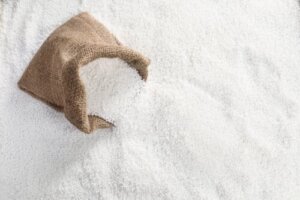Ammonia Salts in Power Sports: What Are Their Effects?


Reviewed and approved by the nurse Leidy Mora Molina
Nowadays, it’s become a trend to use ammonia salts in strength and power sports. These include weightlifting, whether weightlifting or powerlifting, as well as rugby, American soccer, and even combined martial arts combat.
Traditionally, ammonia salts were used to help wake up people who had fainted. This was done because they awaken the senses by triggering reactions in the circulatory system and increasing blood flow and heart rate.
What are ammonia salts, and what are they used for?
Ammonia salts are generally used to refer to preparations based on ammonium carbonates, whose formula is (NH4)2CO3. However, they’re different from the mineral ammonium salt found in their natural state.
These preparations can be purchased in commercial establishments and online stores in various presentations:
- Salts (this is the most common form)
- Blisters that, when broken, release the odor
- A liquid that can be dissolved in water or alcohol
- Wipes or gauze that’s pre-impregnated with the odor
Whatever the presentation, the most common form of use consists of bringing the salt close to the nose and inhaling. This causes an alteration in the nasal mucous membranes and the pulmonary membrane, triggering the inhalation reflex in the sympathetic nervous system, which in turn alters the respiratory pattern, with increased ventilation and a feeling of alertness.
Then, the heart rate increases, as well as the blood flow from the middle artery to the brain. According to studies on the subject, the heart rate can accelerate between +6 and +11 beats per minute, 15 seconds after inhalation.
Because of these effects, ammonia salts are often used to induce resuscitation in people who experience fainting or blackouts or to prevent them from occurring when dizziness occurs.

Like this article? You may also like to read: The 7 Best Breakfasts to Eat Before Practicing Sports
Ammonia salts in power sports
In addition to the uses already mentioned, ammonia salts are now very common in strength and power sports. In fact, a survey indicates that 49% of powerlifting professionals use this resource.
How are they used?
The way to apply them is quite simple:
- Place the container about 10 centimeters from the nostrils. In the case of impregnated clothes, you can bring them a little closer.
- Inhale strongly and deeply.
- Just once should be enough, and it’s not necessary to repeat.
It’s a good idea that the use of ammonia salts in strength sports is limited to competition. Of course, this can also be done during training, but it’s not the most advisable thing to do.
You have to wait a few seconds to feel their effect. However, it also lasts a short time, so it’s best to make the most of the feeling of euphoria they awaken right away.
What are their benefits?
Regarding the beneficial effects of the use of ammonia salts in strength sports, it’s noted that thanks to the increase in blood flow and heart rate, they can affect performance indirectly. In this sense, they are used with an ergogenic purpose, rather than mental or psychological help, by activating a person’s state of alertness.
In some competitions of long duration or when greater fatigue is felt, they can also help an athlete who’s tired. For example, they may be useful in the third round of a combined martial arts combat.
We think you may be interested in reading this, too: Cyber Gambling and Online Sports Gambling: How to Quit
Are ammonia salts useful in power sports?
There are several factors that can influence sports performance. Now, as to whether ammonia salts are useful in strength sports, opinions are divided. Let’s take a look at what the studies say.
1RM and maximal strength
When it comes to strength training, the term 1RM refers to the greatest amount of weight that can be lifted at one time in one exercise. However, studies have not found significant improvements in this regard with salts.
Research has also found no effect on power, maximal force production, or speed of force development during an IMTP (isometric multijoint test).
Explosive strength and ammonia salts
Explosive strength refers to developing a lot of power or speed over short distances or time intervals. This is common in disciplines such as tennis or soccer.
Regarding this point, studies found a positive effect of the use of ammonia salts for sports. In particular, the researchers looked at the effects of such inhalants on anaerobic performance in American soccer.
The activity consisted of performing a series of 5-second maximal effort sprints with 40 seconds of recovery. An anaerobic wingate test was performed before and after. The results showed an increase in PP (peak power) and MP (maximum power) in 90% and 80% of the participants, respectively.

The results are not considered conclusive, so the researchers recommend further investigation.
The side effects and contraindications
The substance must be used with caution. When ammonia is used in household cleaning, for example, it can be toxic to the nervous system. In this respect, some possible reactions are noted:
- Coughing
- Tearing
- Wheezing
- Difficulty breathing
- Pain in the rib cage
- Irritation of the throat and nose
- Dizziness and fainting
However, when used in low concentrations, it’s completely safe and doesn’t have any side effects. Therefore, care should be taken to keep the salts at a distance of 10 centimeters and inhale only once.
As for the risks in sports, some studies report that, due to the euphoria of the moment, the use of ammonia salts in sports masks the incipient signs of injury.
The importance of training
Strength and performance are influenced by many factors. Therefore, it’s important to emphasize that no substance can replace a systematic and well-targeted training routine.
The use of certain aids is OK, as long as it’s not a banned or harmful substance. Fortunately, this is not the case with ammonia salts in strength sports, as their use is not contraindicated by the World Anti-Doping Agency (WADA).
Finally, it’s important not to forget that the ergogenic effect of these substances has more to do with mood and alertness than with actual strength capacity. That said, it’s true that many athletes include them in their rituals.
All cited sources were thoroughly reviewed by our team to ensure their quality, reliability, currency, and validity. The bibliography of this article was considered reliable and of academic or scientific accuracy.
- Odriozola Lino J. Ayudas ergogénicas en el deporte. Arbor. 2000; 165(650), 171–185. https://doi.org/10.3989/arbor.2000.i650.964
- Richmond S, Potts A, Sherman J. The impact of ammonia inhalants on strength performance in resistance trained males. J Exerc Physiol Online. 2014; 17: 60-66.
- Bartolomei S, Nigro F, Luca G, Gabriele S, et al. Acute Effects of Ammonia Inhalants on Strength and Power Performance in Trained Men. The Journal of Strength & Conditioning Research. 2017; 32(1): 244-247.
- Secrest J, Jones E, Faries M, Hearon C. The Effects of Ammonia Inhalants on Anaerobic Performance Following a Simulated American Football Game. International Journal of Exercise Science: Conference Proceedings. 2015; 2(7): 67. DOI:10.1249/01.MSS.0000477345.16772
- Herrick R, Herrick S. Allergic reaction to aromatic ammonia inhalant ampule. A case report. Am J Sports Med. 1983; 11(1): 28. doi: 10.1177/036354658301100108.
- Velásquez J. The use of ammonia inhalants among athletes. Strength & Conditioning Journal. 2011; 33(2): 33-35.
This text is provided for informational purposes only and does not replace consultation with a professional. If in doubt, consult your specialist.








